9727 A FINE GEORGE III MAHOGANY CARLTON HOUSE WRITING TABLE OF UNUSUALLY SMALL PROPORTIONS English. Circa 1800. Measurements: Height: 35 1/2″ (90 cm) Width: 54 3/4″ (139 cm) Depth: 32″ (81 cm)
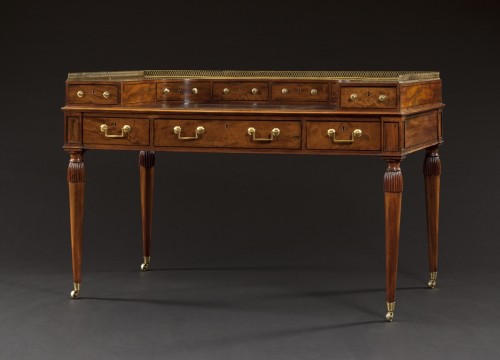
-
Figure 1
Research
Of mahogany, ebony line inlay and fillets, and re-lacquered gilt-brass mounts. The curved superstructure with three-quarter pierced brass gallery is set with six drawers, each mounted with pair knob brass handles. The frieze containing one long and two short drawers to the front, each mounted with Carlton House drop brass handles, the plain sides and back with ebony line inlay and interrupted at each corner by recessed rectangular panels. The circular tapering legs headed by waisted collars and carved Carlton House “tassles.” Each leg terminating in an original brass caster.
Provenance:
Private collection, Munich, Germany.
The Carlton House desk is a particular type of writing table so named for the house to which the original version belonged. It is characterized by having a U-shaped superstructure, which may be multitiered, that is fitted with drawers and sometimes, as in the case of the present desk, a brass gallery. In 1783 Carlton House was given to the Prince Regent, who began furnishing it with pieces that reflected his passion for the burgeoning French style, and whose “correct taste has so classically embellished that beautiful palace.”1
The earliest illustration of the desk’s prototype is found in the second edition of George Hepplewhite’s The Cabinet-Makers’ London Book of Prices (1793), however, a bill in the Prince of Wales’ accounts in the Royal Archive shows that ‘a large Elegant Sattin wood Writing Table containing 15 Drawers and 2 Cupboards’ and with ’16 Elegant Silver handles with Coronets’ was supplied two years before it’s publication. It was the firm Gillows of Lancaster, who also made this variety of desk, that first used the name Carlton House to describe it.
The present example is a particularly refined version of this highly prized form. Being of a rare, small scale, it also has the pleasing attribute of having only one story of drawers in the U-shaped superstructure, which causes the desk to have a sleek, timeless appearance, particularly when viewed from the rear. A closely related example, from the Price Regent’s Palace, can be seen in figure 1.
Footnotes:
1. Agius, Pauline, and Rudolph Ackermann. Ackermann’s Regency Furniture & Interiors. Ramsbury: Crowood, 1984. Print. 81.
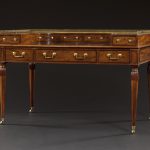
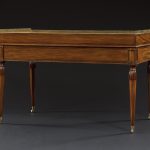
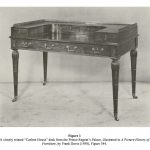
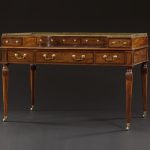
Comments are closed.